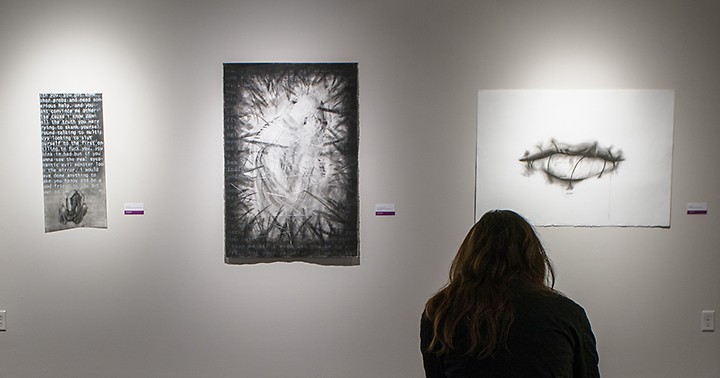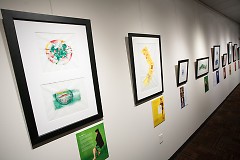What is a “healthy body” or a “healthy mind”? Should they be so highly prized? What role can art play in achieving them? These are questions running through my mind after viewing Art & Healing, an exhibition at Kendall College of Art and Design of Ferris State University’s (KCAD’s) Helen Miller Kendall Gallery through April 8, 2017. As a chronically ill and disabled student at KCAD, I was deeply interested in seeing how this exhibition of art by artists who live with illness and create work around it would address the idea of healing through art.
Disability looks many different ways. For me it looks like a lifetime of chronic pain from injuries, autoimmune diseases/compromised immunity, and mental illness from traumas layered upon traumas. What is most striking to me about the Art & Healing exhibition is that the word disability is never used. In a sense, this is depoliticized work by five artists. The work is explicitly about disability, but that identity is erased, or perhaps never embraced, by the artists in their work and statements about their work. While I find that fact disconcerting, it does get to the heart of exhibit’s intent: finding healing from illness, injury, and disease, and using art as a form of therapy.
I am a working artist, and I use art as a form of therapy as well. After years of unsuccessful medical model (therapy combined with medications) treatment for my bipolar disorder and PTSD, I discovered I could better manage my symptoms through my art. I originally took up painting as a way to offer my then-toddler son a creative outlet. I bought a two-sided easel and we would stand or sit on opposite sides to work. It was both a marvelous way to introduce him to art and to share a hobby together. It didn’t take long for me to realize that painting afforded me an emotional outlet, or to then recognize other art – fiber arts – I engaged with had also been “therapeutic” in a sense. It did take me several years to acknowledge the cycles of my art making coincided with the cycles of my mania and depressive episodes and to find a way to embrace them appropriately.
However, art is so much more than mere therapy, and we risk watering down its strength when we link it that way for people who live with pain, injury, or illness. Art is also a vehicle for education, self-expression of what is otherwise difficult to express, and broadening social awareness/acceptance of a variety of bodies and minds.
Ted Meyer, the nationally renowned artist featured in Art & Healing, says his art “portrays the beauty and humor of physicality while exploring narratives of the human condition.” Meyer lives with a rare illness that has impacted how he views his own body and the diversity of other bodies around him. His eight artworks exhibited come from his “Scarred for Life: Mono-prints of Human Scars” series and include photos and statements from the participants/models whose bodies the prints are literally lifted from. The art itself is abstract, textured, and fascinating. The stories and method of making the art is equally interesting. Meyer’s intent is to empower participants to name their scars and traumas. While never embracing the narrative of disability, the participants name their participation as an act of healing, some accepting their bodies and scars while others say they will never fully accept it. The heavy reliance on a narrative of independence, not being a “burden” on others, and being able to go on with life as if nothing has changed is, however, problematic and inherent in the idea of “healing.” There is humor, wit, and, dare I say, sensuality, in Meyer’s work and the statements of the participants, but healing is not a prerequisite for those qualities.
KCAD invited four students to participate in the exhibition by creating work that addresses what healing through art means to them. Taylor Graham addresses her Type I Diabetes diagnosis, and utilizes both imagery and actual materials from her illness in her work to create nuanced and textural work. Loni Platte favors charcoal as a medium, layered with subtle texts, to produce intense and moving work around anxiety and isolation. The three works by Leilei and Beibei Chen appear to be less personal, but profoundly beautiful and complex, as they look at how the polluted environment creates cancer and bring a Chinese healing perspective to the work.
As a student and artist, I want to like the work itself. The art is, certainly, beautiful, challenging, and interesting. Without any context to anchor its intent, the art is very much worth the viewing. But as a disabled and chronically ill student, there seems to be a piece missing, in which the exhibition doesn’t clarify for me why healing is the end goal of the art. A lot of the language utilized in statements throughout the show was off-putting to me precisely because it set up a narrative of romanticized “courage” in the face of illness and “disfigurement” – ideas and terms that have been rejected by most disabled people. I would like to believe I would be an artist regardless of my disabilities, that art is more than therapy (even as it can absolutely shamelessly also be that). I also know healing of my body and mind is not essential to my life or my art. If anything, art has taught me how to navigate my body and mind and to accept them for what they are now and as they continue to change.
I left the exhibition unsettled. Perhaps this is what good art can do, produce questions that don’t have easy answers. Despite my disagreement with the approach taken, what is clear is how much we need a diversity of disabled voices to have a proper conversation about these issues and experiences. Art & Healing provides an opening to this conversation.
Aaminah Shakur is an artist, culture critic, poet, and currently an undergraduate in KCAD’s Art History department. Shakur identifies as a multi-racial queer crip, and has worked with local disability organizations such as Arts in Motion Studios and DisArt, as well as being a partner in Grand Impact Consulting to provide trainings and workshops through an intersectional lens.
The Rapidian, a program of the 501(c)3 nonprofit Community Media Center, relies on the community’s support to help cover the cost of training reporters and publishing content.
We need your help.
If each of our readers and content creators who values this community platform help support its creation and maintenance, The Rapidian can continue to educate and facilitate a conversation around issues for years to come.
Please support The Rapidian and make a contribution today.


